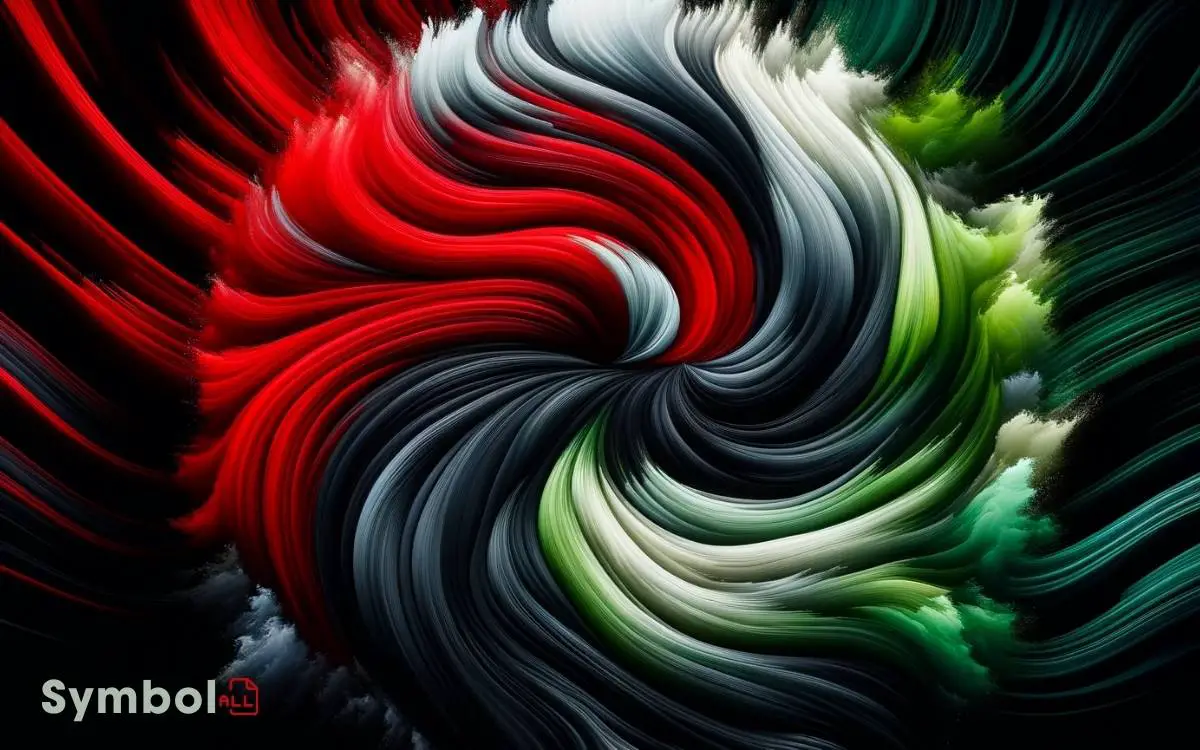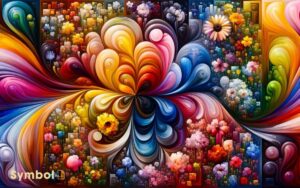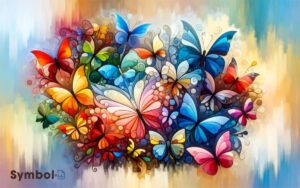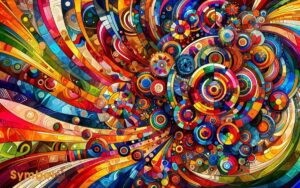What Does the Colors Red Black and Green Symbolize?
You’re exploring the vibrant symbolism of red, black, and green. These colors represent the resilience, identity, and hope of the African diaspora.
- Red stands for the blood shed in their fight for freedom, signaling courage and a fiery spirit.
- Black embodies the people, their deep history, and collective identity, symbolizing strength and unity.
- Green captures the fertile promise of Africa, signifying growth, natural wealth, and optimism for the future.
Together, these colors weave a narrative of solidarity, perseverance, and the quest for liberty. They anchor cultural pride and political activism, offering a deeper connection. And there’s more beneath the surface, capturing the essence of a people’s spirit and aspirations.

Key Takeaways
The Historical Significance
The colors red, black, and green carry a profound historical significance, symbolizing the enduring struggle and resilience of African diaspora communities around the world.
These colors were first adopted by the Pan-African movement, a global effort to unite African people, both on the continent and dispersed through the diaspora, in their common heritage and fight for liberation.
The black represents the people, their identity, and their rich, yet tumultuous history. The green stands for the abundant natural wealth of the African continent, from its fertile lands to its lush landscapes, symbolizing hope, growth, and the promise of a prosperous future.
Together, these colors weave a narrative of solidarity, perseverance, and the unyielding quest for freedom and equality.
Red: Passion and Power
You’ve likely noticed how red captures your attention, embodying both danger and desire. Its emotional impact is profound, evoking feelings of love, anger, and everything in between, shaping its symbolic meanings across cultures.
This duality grants red a unique power in communication, signaling alerts and passions with equal intensity.
Emotional Impact
Red evokes strong emotions, often stirring up feelings of passion and power within you. This vibrant color impacts your psychological state, driving a sense of urgency or alertness.
It’s not just a hue; it’s a demonstration of psychological trigger, enhancing your physical reactions and potentially raising your pulse.
When you encounter red in your environment, it’s not merely a visual experience; it’s an emotional journey. This color’s capacity to influence mood is unparalleled, making it a powerful tool in both personal expression and public communication.
By understanding red’s emotional impact, you’re better equipped to harness its power, whether you’re looking to motivate, persuade, or simply make a statement.
It’s an indication of how color can shape our perceptions and reactions, transcending mere aesthetics to touch the very core of our emotional being.
Symbolic Meanings
Throughout history, red has often symbolized passion and dominance, embodying emotions that resonate deeply with human experience and societal structures.
This color’s association with vitality and ambition isn’t random; it’s rooted in our physiological response to red, which increases heart rate and evokes a sense of urgency.
In political arenas, red banners have rallied individuals around causes, signifying both the fervor of revolution and the strength of leadership. In personal contexts, red’s intensity can signify deep love or anger, illustrating its dual nature in human emotions.
You’ll find that red’s symbolism extends beyond mere aesthetics; it’s a visual language that communicates the depths of human desires, fears, and power dynamics, making it a potent tool in both artistic expression and social movements.
Black: Mystery and Mourning
You’re now entering a domain where black symbolizes the enigmatic and the somber, a shade steeped in complexity and depth. It’s your guide through the shadowy veil of the unknown, inviting you to explore what lies beneath surface perceptions.
As you consider black’s role in cultural mourning practices, you’ll uncover how its depth offers solace and a profound connection to the mysteries of life and death.
Unveiling the Unknown
While often associated with darkness, black also embodies the profound mysteries and the universal process of mourning that touch human experiences across cultures.
You may have noticed this hue enveloping spaces where the unknown is a central theme be it in the vastness of the night sky or the depths of the ocean.
This color’s ability to absorb all light mirrors humanity’s quest for understanding the unseen, marking it as a symbol of both the fear and fascination with the unknown.
Simultaneously, black’s presence in mourning attire isn’t merely a matter of tradition. It reflects the deep void felt with the loss of a loved one, serving as a visual expression of absence and grief. This duality in symbolism showcases black’s rich, multifaceted significance in human life.
Cultural Mourning Practices
In various cultures, the color black symbolizes both the mystery of the unknown and the profound depth of mourning, shaping unique practices that reflect these dual meanings.
When you explore the customs around the world, you’ll find:
- Wardrobe Choices: In the West, it’s customary to wear black clothing to funerals, signifying respect and grief for the departed.
- Flags and Symbols: Many societies raise black flags or wear black bands during periods of mourning, representing the void left by the loss.
- Artistic Expressions: Black is often used in art and literature to depict themes of loss and mourning, serving as a universal symbol of grief.
These practices underscore the intricate relationship between color symbolism and cultural expressions of mourning, offering insight into how societies navigate the complexities of loss.
Depth in Darkness
Delving into the significance of black, we uncover its dual role in symbolizing both the enigmatic allure of the unknown and the profound depths of mourning across cultures.
You’ll find that black embodies the paradox of visibility and invisibility. It’s the color that absorbs all light, creating a void where reflection and introspection become inevitable.
In mourning, black represents the depth of loss, a universal sign of respect and grief. It’s a protective domain, a space where the bereaved can retreat from the vibrancy of life to process their sorrow.
Yet, in the world of the unknown, black invites curiosity and exploration. It holds mysteries that challenge you to look beyond the surface, urging a deeper understanding of the world around you.
Green: Growth and Harmony
Often symbolizing growth and harmony, green frequently appears in nature and cultural expressions as a representation of life and renewal.
Consider the imagery evoked by green:
- The fresh sprout emerging from the soil, signifying the beginning of a plant’s journey toward sunlight and maturity.
- The dense canopy of a forest, a complex ecosystem where diverse species coexist, demonstrating balance and sustainability.
- The calm, steady growth of moss on a rock, illustrating persistence and adaptation over time.
Each instance encapsulates green’s essence, illustrating its role in signaling progress, balance, and a harmonious existence.
Green’s presence in our surroundings isn’t merely a color; it’s a continuous reminder of the natural cycle of growth and the potential for renewal within and around us.
Cultural Interpretations
Across cultures, green embodies a wide array of meanings that reflect societal values, traditions, and beliefs. Analyzing these interpretations, you’ll find they’re deeply rooted in each society’s unique history and environment.
| Culture | Symbolism | Contextual Background |
|---|---|---|
| Irish | Luck | Linked to leprechauns and shamrocks |
| Chinese | Health | Associated with harmony and renewal |
| Islamic | Paradise | Represents gardens of paradise in the Quran |
| Japanese | Youth | Signals new beginnings and freshness |
| Western Societies | Money | Tied to currency and wealth |
This table showcases the diversity in cultural interpretations of green, highlighting its multifaceted significance worldwide.
Each culture attaches its unique values and traditions to this color, offering a rich tapestry of meanings that contribute to our global understanding of green.
Political and Social Movements
The symbolism of red, black, and green transcends mere aesthetics to play pivotal roles in political and social movements, articulating ideologies and rallying communities around shared causes.
These colors have been instrumental in:
- Inspiring revolutionary zeal: Red often embodies the spirit of struggle and sacrifice, igniting the passion needed for communities to pursue radical change.
- Asserting identity and unity: Black represents the determination and resilience of marginalized groups, fostering a sense of solidarity and collective identity.
- Advocating for environmental and social justice: Green symbolizes the connection to the land and the need for sustainable development, pushing for policies that promote fair access to resources.
Analyzing these colors within the context of political and social movements offers you deep insights into how they communicate complex messages and mobilize action toward common goals.
The Pan-African Flag
Embodying the spirit and struggle of the African diaspora, the Pan-African flag utilizes red, black, and green to symbolize unity, resilience, and hope among people of African descent.
Created by Marcus Garvey and the Universal Negro Improvement Association in 1920, this flag’s colors hold deep meanings. Red represents the blood that unites all people of African ancestry, and the bloodshed in their fight for liberation and justice.
Black signifies the people, highlighting the identity and shared experiences of the African diaspora. Green symbolizes the abundant natural wealth of Africa, from its fertile lands to its verdant landscapes, reflecting a common hope for prosperity and growth.
Together, these colors weave a narrative of collective struggle, identity, and aspiration, transcending borders to unite Africans worldwide.
Modern Representations and Uses
In recent years, the symbolic colors of red, black, and green have found new life and meaning, permeating various aspects of culture and identity among the African diaspora.
These colors have evolved beyond their historical context to symbolize:
- Unity and Pride: Worn in clothing and accessories, they serve as a visible declaration of solidarity and cultural pride.
- Political Activism: At demonstrations and social justice events, these colors amplify messages of liberation, equality, and empowerment.
- Cultural Expression: In art, literature, and digital media, red, black, and green are employed to explore and celebrate African heritage and its diasporic roots.
This recontextualization enriches their significance, making them not just symbols of a historical struggle, but active agents in the ongoing pursuit of identity and autonomy.
Conclusion
To put it simply, the colors red, black, and green weave a vivid tapestry of human emotion and societal evolution.
Like a river that carries both the ferocity of its rapids (red’s passion) and the deep secrets in its depths (black’s mystery), society flows towards a greener, more harmonious future.
These colors, embraced by movements and cultures, symbolize our collective journey towards empowerment, identity, and growth.
They’re not just hues; they’re the heartbeat of our shared story, pulsating with the rhythm of change.






